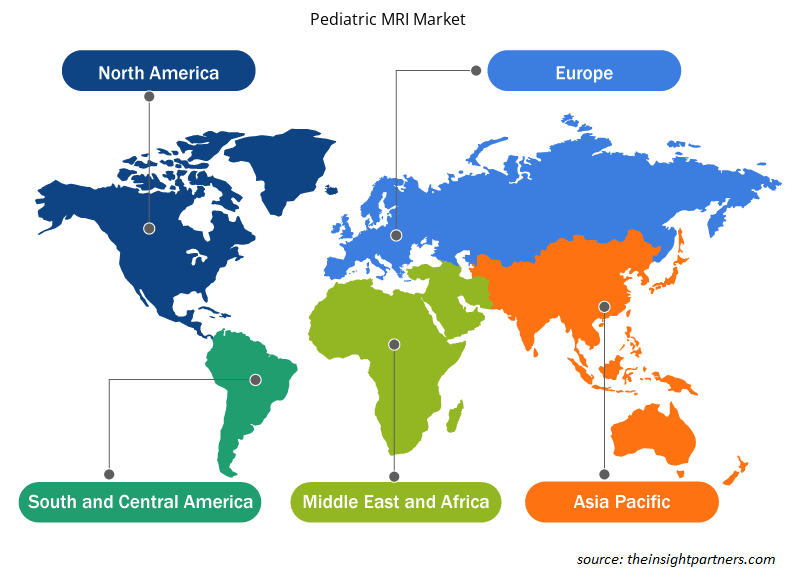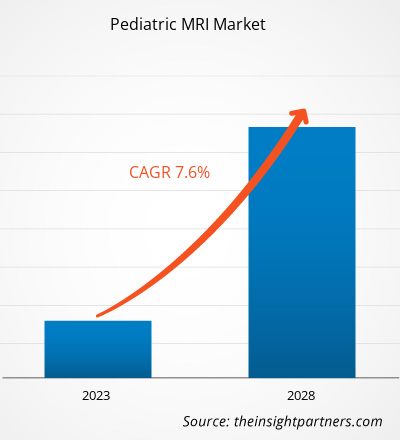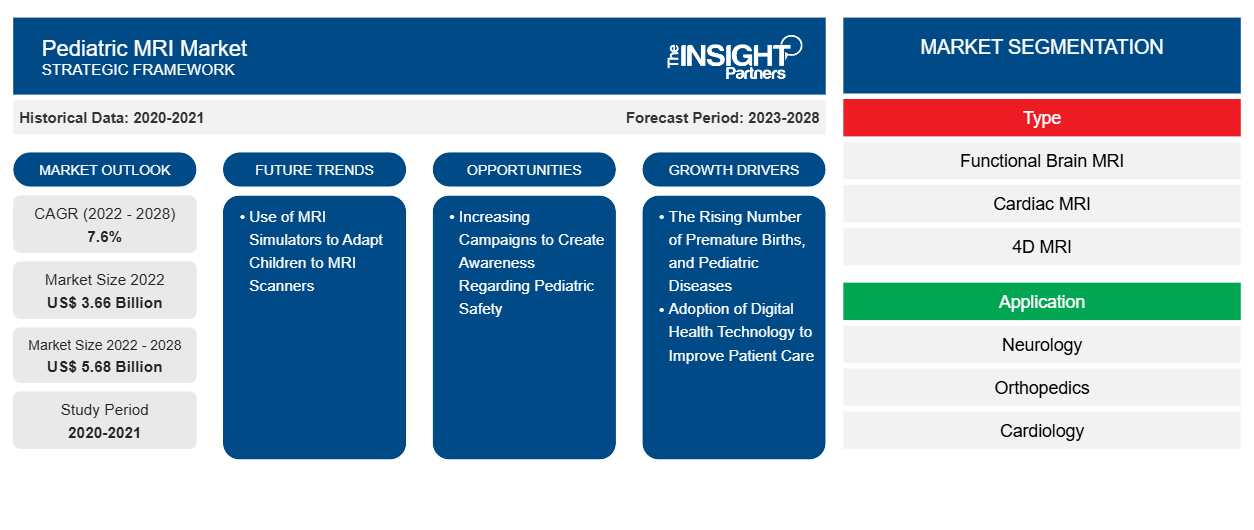[研究报告] 2022年儿科MRI市场价值为36.5532亿美元,预计到2028年将达到56.7886亿美元;预计2022年至2028年的复合年增长率为7.6%。
分析师观点:
早产和儿科疾病负担的不断加重、儿科护理对先进医疗实践的需求、政府提高对儿科疾病认识的举措以及新型儿科成像技术的普及率不断提高,是推动儿科 MRI 市场增长的几个关键因素。此外,市场参与者对新产品开发和战略合作以开发先进儿科 MRI 的关注度不断提高,预计将在未来几年推动市场增长。就地区而言,北美拥有最大的儿科 MRI 市场份额,其次是欧洲。然而,由于中国和印度等国家早产病例的增加,预计亚太地区将在预测期内在儿科 MRI 市场中录得最高的复合年增长率。
市场概况:
儿童磁共振成像(MRI) 使用磁场、无线电波和计算机来生成儿童体内的详细图片。它用于诊断或监测脑、胸、腹、骨盆、先天性畸形和四肢内各种疾病的治疗。儿童 MRI 市场的增长归因于几个关键驱动因素,例如早产和儿科疾病数量的增加以及采用数字医疗技术来改善患者护理。此外,为加强儿科护理而开展的合作和产品发布不断增加,可以推动全球儿童 MRI 市场的增长。在预测期内,越来越多的提高儿科安全意识的活动也预计将为各地区儿童 MRI 市场的增长提供充足的机会。
定制此报告以满足您的需求
您可以免费定制任何报告,包括本报告的部分内容、国家级分析、Excel 数据包,以及为初创企业和大学提供优惠和折扣
- 获取此报告的关键市场趋势。这个免费样品将包括数据分析,从市场趋势到估计和预测。
市场驱动因素:
早产和儿科疾病数量增加推动儿科 MRI 市场增长
早产儿是指在怀孕 37 周前出生的婴儿。大多数早产发生在南亚和撒哈拉以南非洲。多胎妊娠、感染和慢性病等多种因素都可能导致早产,这在过去几年中已成为一个全球性问题。早产会限制婴儿的生长。根据世界卫生组织 (WHO) 的报告,每年约有 1500 万早产儿出生。该报告还指出,约 184 个国家的早产率为 5-18%,其中 60% 以上的早产发生在亚太地区和非洲。此外,每年约有 100 万婴儿死于早产并发症。早产并发症是五岁以下儿童死亡的主要原因,2019 年导致约 90 万人死亡。根据美国疾病控制和预防中心 (CDC) 的数据,截至 2021 年,美国出生的儿童中约有十分之一受到早产的影响。 2021 年早产率上升了 4%,从 2020 年的 10.1% 上升至 2021 年的 10.5%。根据世界卫生组织的数据,2020 年出生的婴儿的早产率为 4% 至 16%。
磁共振成像 (MRI) 是一种有助于监测早产儿大脑发育的宝贵工具。这种成像方式有助于评估多种病症,例如脑室周围白质软化、脑室内出血和脑室周围出血性梗塞。根据北美放射学会发表的一项研究“MRI 识别早产儿异常大脑发育标志”,青少年时期患上自闭症、脑瘫和其他异常的早产儿的大脑结构差异很小,可以通过定量 MRI (qMRI) 检测出来。根据世界卫生组织的数据,2019 年,约有 520 万五岁以下儿童死于可预防和可治疗的疾病。五岁以下儿童容易感染疟疾、腹泻、肺炎、艾滋病毒和结核病等传染病。据联合国儿童基金会称,肺炎是五岁以下儿童死亡的首要传染病,每年约有 70 万名儿童因此死亡。然而,这些疾病是可以预防或通过及时诊断治愈的。
因此,早产病例的增加和儿科疾病患病率的上升促进了儿科 MRI 的采用,从而推动了市场的增长。
节段分析:
根据类型,儿科 MRI 市场细分为功能性脑 MRI (fMRI)、心脏 MRI、4D MRI 等。功能性脑 MRI (fMRI) 部分在 2022 年占据了儿科 MRI 市场的最大份额。然而,预计 4D MRI 部分将在 2022-2028 年期间实现最高复合年增长率。该细分市场的市场增长归因于全球早产率的增加和创伤性脑损伤发病率的增加。功能性磁共振成像 (fMRI) 专注于大脑并记录随时间推移的代谢活动。fMRI 测量大脑活动时发生的血流细微变化。它检查大脑的功能解剖结构,检查中风和其他疾病的影响,并指导大脑治疗。fMRI 还提高了研究人员对儿童发育路线和疾病状态下神经网络可塑性的理解。另一方面,4D 医学成像技术通过结合时间信息,提高了 MRI 在三维以外的性能。患有肺动脉高压的儿童每次接受导管插入术时都有发生心脏事件的风险。4D MRI 可以全面评估复杂的血流模式并灵活地回顾性量化流动参数。
根据应用,儿科 MRI 市场细分为心脏病学、骨科、神经内科、肿瘤学等。神经内科部门在 2022 年占据了儿科 MRI 最大的市场份额,预计未来几年将实现最高的复合年增长率。该部门的市场增长是由越来越多的创伤病例推动的,这些病例需要更快、更准确的成像解决方案。对于大脑、颈部、脊柱和神经系统的损伤和疾病,神经影像有助于确保准确性。儿科神经影像涉及一层专业化,因为大脑发育涉及许多复杂因素。磁共振成像的神经系统应用包括脊髓和脑肿瘤、炎症、感染、损伤等的诊断。MRI 还有助于检测和监测多发性硬化症等退行性神经系统疾病,并记录创伤造成的脑损伤。
根据产品类型,儿科 MRI 市场分为设备和线圈设计。设备部分在 2022 年占据了更大的市场份额,预计在 2022-2028 年期间将实现更高的复合年增长率。该细分市场的市场增长归因于各种优势,包括降低儿科和胎儿成像的风险、减少镇静和重新扫描的需求,以及优化患者舒适度(尤其是儿科患者)。儿科 MRI 设备允许安全的儿科颈椎运动限制和固定技术,以有效定位、运输和固定受脊柱损伤或需要约束的患者。
根据年龄组,儿科 MRI 市场分为胎儿期、新生儿期(0-27 天)、婴儿和幼儿期(28 天至 23 个月)、儿童期(2-11 岁)和青少年期(12-18 岁)。青少年期(12-18 岁)细分市场在 2022 年占据了最大的市场份额。然而,儿童期(2-11 岁)细分市场预计在预测期内将录得最高复合年增长率。青少年期(12-18 岁)细分市场的市场增长归因于创伤病例的增加,这推动了对更快、更准确的成像解决方案的需求。然而,由于儿童受伤、疾病和先天畸形病例的增加,儿童期(2-11 岁)细分市场的市场预计在未来几年将增长。根据 2022 年 2 月发表的题为“神经母细胞瘤治疗”的文章,神经母细胞瘤的发病率约为每 7,000 个活产婴儿中有 1 例。15 岁以下儿童的发病率为每年每 100 万例 10.54 例。根据同一来源,约 90% 的患者在诊断时未满五岁。
根据最终用户,儿科 MRI 市场细分为医院、儿科诊所、诊断中心和其他。医院部门在 2022 年占据了最大的市场份额,预计在预测期内将实现 8.0% 的最高复合年增长率。医院部门的市场增长归因于各种疾病患病率的上升、全球医院数量的增加以及各种外科手术的快速增长。此外,政府对医院的资助不断增加以及儿科患者住院率的上升也促进了儿科 MRI 市场的增长。
区域分析:
2022 年,北美占据了儿科 MRI 市场的最大份额。由于技术进步、产品发布增加、配备现代设备和仪器的发达医疗设施中心以及确保患者获得最大便利的技术进步等因素,它在全球市场占据主导地位。由于儿科成像技术的技术进步不断提高,以及为加强儿科护理而不断增加的合作、批准和发布,美国占据了北美儿科 MRI 市场的最大份额。此外,早产数量增加、儿科疾病患病率上升以及对预防保健和成像解决方案的高需求推动了美国对儿科 MRI 系统的需求。
此外,亚太地区的儿科 MRI 市场预计在未来几年将大幅增长。该地区市场的增长归因于儿科人口的增加和医疗保健基础设施的改善以及有效儿科成像工具的普及。中国和日本是该地区儿科 MRI 市场的主要贡献者。由于社会经济的快速发展、环境问题、生活方式的改变和城市化进程的加快,中国在维持和增进人民健康方面面临着诸多障碍。儿童道路交通事故伤害案件也是中国的主要公共卫生问题。儿童事故可能导致创伤性脑损伤,预计这将推动中国儿科 MRI 市场的发展。此外,日本报告的道路交通事故大幅增加,这推动了该国对儿科 MRI 的需求。它用于帮助诊断因受伤、疾病或先天性异常而导致的儿童多种疾病。它可以检测各种脑部疾病和异常,如囊肿、肿瘤、出血、肿胀和血管问题。上述因素推动了日本儿科 MRI 市场的增长。
关键球员分析:
儿科 MRI 市场主要由西门子医疗股份公司、Advanced Imaging Research Inc、LMT Medical Systems GmbH、Hyperfine Inc、GE HealthCare Technologies Inc、Neoscan Solutions GmbH、Aspect Imaging Ltd、NORAS MRI products GmbH、Koninklijke Philips NV 和 Time Medical Holding 等几家公司组成。GE HealthCare Technologies Inc 和 Koninklijke Philips NV 凭借其多元化的产品组合成为市场上排名前两位的公司。
儿科 MRI 市场区域洞察
Insight Partners 的分析师已详尽解释了预测期内影响儿科 MRI 市场的区域趋势和因素。本节还讨论了北美、欧洲、亚太地区、中东和非洲以及南美和中美洲的儿科 MRI 市场细分和地理位置。

- 获取儿科 MRI 市场的区域特定数据
儿科 MRI 市场报告范围
| 报告属性 | 细节 |
|---|---|
| 2022 年市场规模 | 36.6亿美元 |
| 2028 年市场规模 | 56.8亿美元 |
| 全球复合年增长率(2022 - 2028) | 7.6% |
| 史料 | 2020-2021 |
| 预测期 | 2023-2028 |
| 涵盖的领域 | 按类型
|
| 覆盖地区和国家 | 北美
|
| 市场领导者和主要公司简介 |
|
儿科 MRI 市场参与者密度:了解其对业务动态的影响
由于消费者偏好的不断变化、技术进步以及对产品优势的认识不断提高等因素,终端用户需求不断增加,推动了儿科 MRI 市场快速增长。随着需求的增加,企业正在扩大其产品范围,进行创新以满足消费者需求,并利用新兴趋势,从而进一步推动市场增长。
市场参与者密度是指在特定市场或行业内运营的企业或公司的分布情况。它表明在给定市场空间中,相对于其规模或总市场价值,有多少竞争对手(市场参与者)存在。
在儿科 MRI 市场运营的主要公司有:
- 西门子医疗股份公司
- 先进成像研究公司
- LMT 医疗系统有限公司
- 超精细公司
- 通用电气医疗科技公司
免责声明:上面列出的公司没有按照任何特定顺序排列。

- 了解儿科 MRI 市场主要参与者概况
最新动态:
儿科 MRI 市场中的公司普遍采用并购等无机和有机战略。以下列出了一些近期的关键市场发展:
- 2023年3月,美时医疗在大埔创新园MARS中心正式启用香港新生产基地,成为香港首个大型医疗设备生产基地,也是粤港澳大湾区及东南亚最大的磁共振生产基地,专注于高附加值的新生儿及乳腺筛查超导磁共振系统的研发及生产。
- 2023 年 2 月,Hyperfine, Inc. 的 Swoop 系统获得了 CE 标志,这是世界上第一个获得 FDA 批准的便携式 MRI 系统。虽然该公司的商业重点仍集中在美国,但 CE 标志为其进入欧洲经济区 (EEA) 的潜在商业扩张打开了大门。
- 2023 年 2 月,美时医疗的新生儿 MRI 系统 NEONA 获得美国 FDA 批准。它是世界上第一台专用于儿科诊断的超导 MRI 系统,可以显著提高脆弱的新生儿、婴儿和儿童的诊断精度和图像质量。这项创新产品重量轻、结构紧凑,可放入新生儿重症监护室 (NICU),大大降低了移动年轻患者的健康风险。
- 2022 年 6 月,Hyperfine, Inc. 获得 FDA 510(k) 批准,并推出了 Swoop 系统新序列,扩展了系统的功能,并缩短了患者的脑部扫描时间。该系统的新软件使用深度学习来提供清晰的图像,有助于临床诊断。
- 2022 年 6 月,Hyperfine, Inc. 完成了 Swoop 设备在澳大利亚和新西兰的注册和通知。通过此举,Swoop 系统现已在两个国家/地区可供购买,并包括美国 FDA 批准的使用深度学习的高级重建软件。Quantum HealthCare 成为该公司在澳大利亚和新西兰的产品经销商。
- 历史分析(2 年)、基准年、预测(7 年)及复合年增长率
- PEST和SWOT分析
- 市场规模、价值/数量 - 全球、区域、国家
- 行业和竞争格局
- Excel 数据集
近期报告
客户评价
购买理由
- 明智的决策
- 了解市场动态
- 竞争分析
- 客户洞察
- 市场预测
- 风险规避
- 战略规划
- 投资论证
- 识别新兴市场
- 优化营销策略
- 提升运营效率
- 顺应监管趋势























 获取免费样品 - 儿科MRI市场
获取免费样品 - 儿科MRI市场